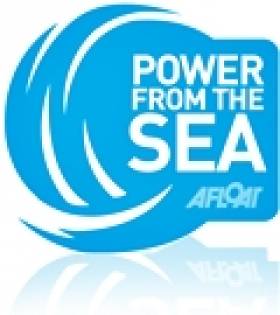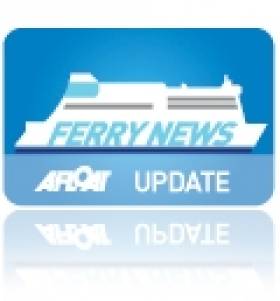Displaying items by tag: Dong Energy
Belfast Harbour’s New Wind Terminal to Bring Huge Rewards
#DONGenergy - Belfast Harbour's new wind terminal assembly facility has created a fantastic opportunity for further inward investment, according to the head of one of the companies making turbines in the city.
Keith Anderson, chief corporate Officer of ScottishPower, was speaking as the firm's parent company Iberdrola reported first half earnings of €4.1bn (£3.5bn).
In Belfast, Scottish Power and Danish energy giant DONG energy currently sublet a a 50-acre terminal, the largest single investment in Belfast Harbour's 400-year history and the first purpose-built offshore wind installation and pre-assembly harbour in the UK or Ireland.
For more on this story The Belfast Telegraph reports.
£50m Offshore Wind Terminal Completed in Belfast Harbour
#BelfastWindTerminal - A new £50m offshore wind terminal which has been completed in Belfast Harbour, has been handed over to DONG Energy and ScottishPower Renewables.
As previously reported on Afloat.ie, the terminal, the first purpose-built offshore wind installation and pre-assembly harbour in the UK or Ireland, will be used as a hub to help service a market valued in excess of 100bn. Up to 300 jobs are expected to be created, ranging from welders to electricians and engineers.
The official hand-over was attended by Northern Ireland's First and Deputy First Ministers, Peter Robinson MLA and Martin McGuinness MLA, along with Len O Hagan, Belfast Harbour's Chairman and Brent Cheshire, DONG Energys UK Country Chairman.
DONG Energy has signed a lease for the terminal which will be used initially to support the development of the West of Duddon Sands Wind farm in the Irish Sea, a joint venture between ScottishPower Renewables and DONG Energy. Work on the wind farm has already started and Belfast Harbour has received its first shipment of wind farm components. Its anticipated that the first turbines will depart Belfast this summer for erection at the site.
Welcoming the handover, Len OHagan, Belfast Harbour's Chairman, said: "Delivering this immense project on time and on budget has been a major achievement. This is a historic development for Belfast which has the potential to usher in a major new industry for Northern Ireland a development which is all the more poignant given that this is the Harbours 400th anniversary year".
He added "Over the years the harbour has helped bring other industries to Belfast such as shipbuilding and aerospace by investing heavily in infrastructure and land reclamation. This is a continuation of that strategy and a demonstration of our long-term commitment to enhance the local economy".
The 50-acre terminal, located on the Co. Down side of the port, is the largest single investment in Belfast Harbours 400-year history. Built by local construction company Farrans, the project took 15-months, 750,000 man hours, one million tonnes of stones and 30,000 tonnes of concrete to complete.
The 200,000 m2 facility, large enough to accommodate 30 football pitches, includes a 480m deep-water quayside. Up to three vessels will be able to berth simultaneously with access available around the clock.
Brent Cheshire, DONG Energys UK Country Chairman commented: "Having a bespoke facility at our fingertips will help us plan our offshore construction very effectively and help with our work to lower the cost of offshore wind farms. The site is in an excellent strategic position for DONG Energy as we have several wind farms under development in the Irish Sea. This is a port that can handle the large number of huge pieces of equipment required".
Keith Anderson, ScottishPower Renewables CEO, added: "The facility at Belfast Harbour is one of the most advanced anywhere in the world for the assembly of offshore wind turbines, and we are delighted to be taking over the lease as we start offshore construction on the West of Duddon Sands project.
This marks a significant milestone for the West of Duddon Sands project, and we are sure that Belfast will play a hugely important role in its successful delivery. The investment in Belfast Harbour will ensure that the city has a long-term future as a leader in renewable energy.
Over 100 turbines, each with a rotor diameter of 120m, will be shipped from the new terminal to the West of Duddon Sands project. It will be one of the worlds largest offshore wind farms when it is commissioned in 2014.
The UK is Europes leading offshore wind generator and has plans to develop 11,000 new offshore wind turbines, a quarter of which are expected to be built within 150 nautical miles of Belfast. It is anticipated that 32 gigawatts of electricity, one quarter of the nations electricity needs, will be provided by offshore wind.
Belfast Harbour’s Tonnage Record in 2012
#BelfastHarbour – Figures released by Belfast Harbour reveal that trade handled by the port during 2012 rose to a record 19.6m tonnes, up 11% on the previous year. The growth was driven primarily by an improved performance in the bulk and roll-on / roll-off (freight vehicle) sectors.
A record 4.6 million tonnes of dry-bulk was handled, a jump of 16%. This included 2m tonnes of grain and animal feeds, the highest tonnages ever recorded by the harbour in this sector.
An additional 600,000 tonnes of coal was also handled, reflecting recent investments by the harbour in deep-water facilities which have enabled it to handle coal imports for AES's power station at Kilroot, on the northern coast of Belfast Lough. Coal imports are now in excess of 1m tonnes for the first time since 1996.
Major investments by Belfast Harbour and Stena Line in new terminals on both sides of the Irish Sea, plus a pair of new superfast ferries, have significantly enhanced the competitiveness of the Belfast – Cairnryan route.
Port Tonnages Rise by 11%
This, coupled with a record performance on the Belfast – Heysham route, helped drive the number of freight vehicles passing through the Port to 432,000, up 21% since 2011.
Commenting on the figures, Roy Adair, Belfast Harbour's CEO, commented: "It's greatly encouraging for Belfast Harbour to once again be able to report such a positive set of trade figures. Growth across a number of sectors reaffirms Belfast's position as one of the most efficient ports in these islands and helps benchmark the harbour's ongoing contribution to the Northern Ireland economy.
"Long-term investments by the harbour and by key port users such as Stena Line have delivered significant benefits to the regional economy. It is particularly pleasing that the roll-on / roll-off traffic has performed so strongly in what is one of the most competitive sectors in the port industry. "
Liquid Bulk total imports in 2012 remained steady compared with the previous year, with 2.1 million tonnes handled. Container traffic fell back by 5% to 123,000 boxes as consumer demand continued to soften. Construction related trades such as timber also continued to decline. Timber imports fell for the seventh year in a row, down by 9%.
On a more positive note, there was some indication of a recovery in activity in Northern Ireland's manufacturing base with steel imports rising by 11% to 128,000 tonnes, the highest level since 2008.
Passenger numbers using the port's ferry services also increased by 11% to almost 1.4 million, reflecting the growing popularity of 'holidays at home' and major boosts to Northern Ireland's tourist sector with the opening of Titanic Belfast and the new Giant's Causeway visitor centre. The 'Titanic' effect was even more evident in the cruise sector with 45 ships and 75,000 visitors calling at Belfast in 2012 – a rise of 40% since 2011.
Joe O'Neill, Belfast Harbour's Commercial Director added: "While the overall trend in tonnages handled is positive, the harbour is ever mindful that the wider economic outlook remains challenging. The record level of trade handled in 2012 was a direct consequence of a major investment programme; similar investments will be required for the long-term competitiveness of the port.
"For example, the trend for ever larger vessels plus Belfast's growing popularity as a cruiseship destination – bookings for 2013 are already up by over 25% - will require further investments in the port's deep water facilities to accommodate demand.
"Belfast Harbour will also continue to pursue major marine projects such as the development of a £50m, 50-acre offshore wind farm terminal for DONG Energy."
Wind-Farm Proposal Requires No Isle of Man Shipping Re-routing
#MANX FERRY – A proposed extension to an offshore wind farm off Cumbria on the north-west coast of England will not require any re-routing of Isle of Man shipping lanes, say the developers.
A Dong Energy spokesman said the 200-turbine development would not, in isolation, present any problems. The extension is being proposed to a 102-turbine wind farm off Walney Island. The facility is said to be one of the largest in the world and in which opened earlier this year.
Emily Marshall, from Dong Energy, said: "We can confirm that re-routing shipping lanes will not be an issue." She added: "However, the Irish Sea is getting busier with other projects in the development phase and we are undertaking cumulative impact assessments for people who are concerned, with regards to commercial interests."
#BELFAST HARBOUR -The largest port in the north reported improved turnover and profit during 2010-2011, according to the annual report of Belfast Harbour.
The port showed a 2% rise in profit before taxation to £17.8m and a 4% increase in turnover to £36.1m. Underpinning the harbour's performance were record levels of tonnages handled during the period - up 7% to 17.6m tonnes. Although some sectors, such as those related to construction, continued to struggle, this was offset by growth elsewhere.
The number of freight vehicles passing through the port rose by 14% to 357,000 and a record four million tonnes were handled in the dry-bulk sector, which includes trades such as aggregates and coal.
Belfast Harbour noted that capital expenditure projects valued at £18.3m were completed during 2010-11. A further £53.8m was committed to additional projects at the year end, principally the development of the UK's first dedicated offshore wind logistics terminal for DONG Energy.
Len O'Hagan, Belfast Harbour's Chairman, said: "In spite of ongoing sluggishness in both the UK and Irish economies, Belfast Harbour has posted a very strong set of results for 2011, reflecting the diverse nature of the business and a long-term strategy of major capital investment to ensure that Belfast offers the most modern maritime facilities on the island.
"Significant uncertainty, however, still exists in the global economy, with the UK officially falling back into recession and the continuing eurozone crisis which is undermining business confidence throughout the continent and beyond.
"There are still opportunities for growth, though, particularly in renewable energy where Belfast Harbour is investing £50m in a new terminal for the assembly of offshore wind turbines. There have also been opportunities to further develop Belfast Harbour Estate, not least the Titanic Belfast visitor attraction, which received a £13.6m donation from Belfast Harbour, and the Northern Ireland Science Park which was the subject of a £6m investment by the Harbour to facilitate a 55,000 sq ft expansion."
During the year the port benefitted from several developments within the Irish Sea ferry sector, including the opening of Stena Line's new Scottish terminal at Loch Ryan Port (Cairnryan) and introduction of a pair of larger and more modern vessels. During this timeframe Stena Line had completed its takeover of DFDS Seaways Belfast - Birkenhead route and freight-only service to Heysham.
Mr O'Hagan added: "Although the overall performance of Belfast Harbour has been strong, it is clear that economic recovery across the UK and Ireland remains patchy. Belfast Harbour, however, is committed to its long-term strategy of investing in infrastructure to maintain the Port's competitiveness and provide much needed capital projects for the construction industry."
Trade, Tonnage and Turnover Up in Belfast Harbour
The principle driver in the ports performance came from the agri-food sector with a record 2m tonnes of grain and animal feed imports. The sector also recorded fertiliser imports alone leap by 32%, reflecting the major investment by the harbour in recent years in the dry-bulk cargo trade.
Roll-on roll-off (Ro-Ro) accounted for a 2% rise to 313,000 vehicles carried, partly due to the introduction of newer larger tonnage on the Belfast-Heysham route.
Belfast Harbour Chairman, Len O'Hagan, said: "Although trading conditions in the UK and Ireland remain weak, the increase in tonnages handled by Belfast Harbour suggests that business confidence is starting to return, albeit slowly.
"Belfast Harbour continues to operate in a highly competitive port sector, but I am pleased to note that the £160m which the Harbour invested in new facilities during the past decade has enabled it to emerge from the downturn with new customers and a presence in new sectors such as renewable energy.
Capital investment in the port worth almost £6m were undertaken during 2010, including the purchase of a new mobile crane, a 10,000 sq ft expansion in logistics space and preliminary works to support the proposed development of an offshore wind turbine terminal for DONG Energy (click HERE). The combined capital expenditure in these projects is in excess of £60m.
Within the ports real estate, projects at the Titanic Quarter progress at the Public Record Office, Belfast Metropolitan College and the core attraction of the 'Titanic Belfast' visitor centre.
Master planning for the 24-acre mixed-use City Quays site adjacent to the Harbour Office was secured. In addition planning permission was lodged for a 230,000 sq ft of space at Sydenham Business Park on the south-eastern fringes of the harbour.
Further upstream closer to the city-centre at the Abercorn Basin, initial work had been completed on a marina where there are more plans for the development of a 250-berth full-service leisure facility.
Next Monday the port's cruise business is to welcome a new cruiseship, the 66,000 tonnes Marina of Oceania Cruises. The 1,250-passenger /800 crew newbuild's arrival to Belfast comes in a year that marks the thirteenth anniversary since the first liner docked in the city. In 2011 over 30 such vessels are due to visit bringing some 50,000 passengers and crew.
- RORO
- Marina
- Port of Belfast
- Titanic
- Belfast Lough
- Belfast Harbour
- Titanic Quarter
- Len O'Hagan
- Belfast Harbour Commissioners
- Cruiseships
- Ports and Shipping News
- Dong Energy
- BelfastHeysham
- Belfast Lough News
- Drybulk
- Abercorn Basin
- Belfast Harbour Chairman Len O'Hagan
- Titanic Belfast
- Marina Oceania Cruises
- Offshore Wind Turbines
- Belfast Metropolitan College
- Sydenham Buinsess Park
- Belfast Harbour real estate
Major Wind-Energy Hub Planned for Belfast Port
Belfast Harbour could potentially become one of the leading energy renewable hubs in the UK, when DONG Energy, a leading Danish energy firm, signed a letter of intent yesterday for an agreement to progress on a number of offshore wind farm projects in the Irish Sea.
In addition as part of the project, Belfast Harbour are to invest £40m in the development of a new 450-m long quay. The facility will be adjoined by a 50-acre logistics space on the southern shoreline of the port's docklands estate on Belfast Lough. The construction phase will create 150 jobs and up to 300 full time positions when the facility is completed, where the wind turbines and their foundations will be pre-assembled.
At that stage the large wind farm components will then be loaded onto specialist wind farm installation /construction vessels as depicted on the image by clicking here and to read further information on the overall project.
Attending the announcement which was held in Belfast Harbour Office, were representatives from the Northern Ireland Executive, Peter Gedbjerg, Vice President and UK Country Manager of DONG Energy, and Len O'Hagan, Chairman of Belfast Harbour. The energy hub scheme represents one of the harbour's largest ever capital investment projects.



































































